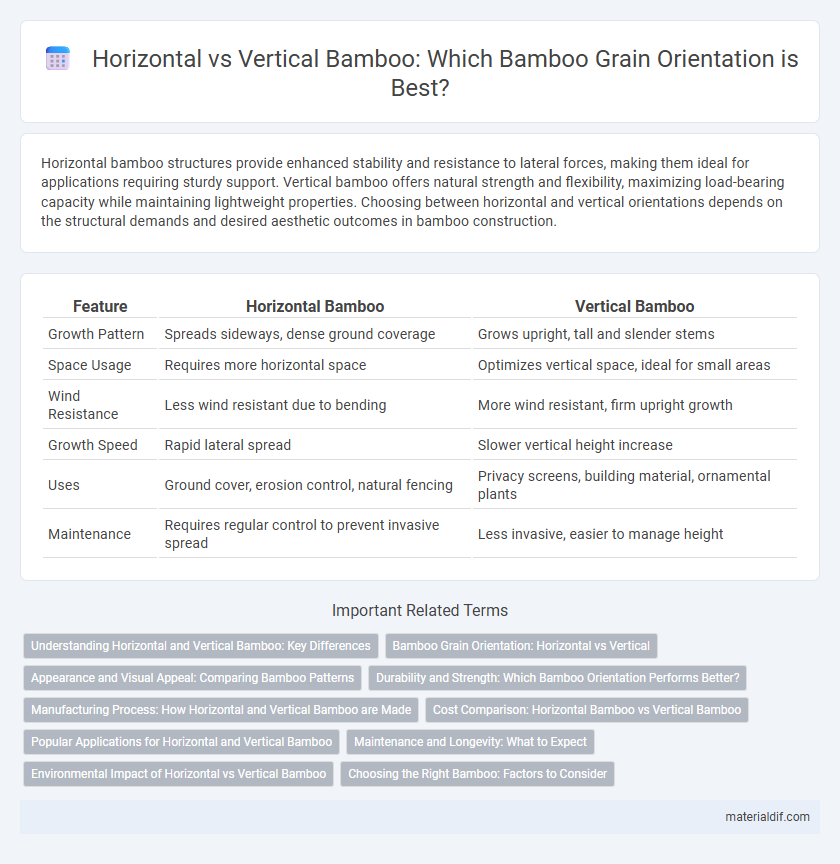Horizontal bamboo structures provide enhanced stability and resistance to lateral forces, making them ideal for applications requiring sturdy support. Vertical bamboo offers natural strength and flexibility, maximizing load-bearing capacity while maintaining lightweight properties. Choosing between horizontal and vertical orientations depends on the structural demands and desired aesthetic outcomes in bamboo construction.
Table of Comparison
| Feature | Horizontal Bamboo | Vertical Bamboo |
|---|---|---|
| Growth Pattern | Spreads sideways, dense ground coverage | Grows upright, tall and slender stems |
| Space Usage | Requires more horizontal space | Optimizes vertical space, ideal for small areas |
| Wind Resistance | Less wind resistant due to bending | More wind resistant, firm upright growth |
| Growth Speed | Rapid lateral spread | Slower vertical height increase |
| Uses | Ground cover, erosion control, natural fencing | Privacy screens, building material, ornamental plants |
| Maintenance | Requires regular control to prevent invasive spread | Less invasive, easier to manage height |
Understanding Horizontal and Vertical Bamboo: Key Differences
Horizontal bamboo spreads laterally through underground rhizomes, creating dense, interconnected groves, making it ideal for ground cover and erosion control. Vertical bamboo grows upward from a single point, with shoots that rise straight and tall, often used for privacy screens or ornamental purposes. Understanding the growth patterns and spatial requirements of horizontal versus vertical bamboo is crucial for efficient landscape design and maintenance.
Bamboo Grain Orientation: Horizontal vs Vertical
Horizontal bamboo grain orientation showcases fibers aligned parallel to the ground, enhancing flexibility and aesthetic appeal in flooring and paneling applications. Vertical bamboo grain orientation displays fibers running perpendicular to the ground, offering increased structural strength and stability suited for construction and heavy-duty furniture. Selecting between horizontal and vertical grain influences the durability, appearance, and functional properties of bamboo products tailored to specific design and engineering requirements.
Appearance and Visual Appeal: Comparing Bamboo Patterns
Horizontal bamboo features a wider, more spaced-out pattern that emphasizes the natural grain and knots, creating a rustic and organic appearance. Vertical bamboo displays a sleek, uniform alignment that enhances height perception and delivers a modern, streamlined visual appeal. The choice between horizontal and vertical bamboo patterns significantly influences interior aesthetics by balancing texture richness against structural elegance.
Durability and Strength: Which Bamboo Orientation Performs Better?
Horizontal bamboo structures exhibit superior flexibility and resistance to lateral forces due to the natural grain alignment, enhancing durability in dynamic environments. Vertical bamboo, aligned along the stiff culm axis, offers greater compressive strength, making it ideal for load-bearing applications. Overall, horizontal bamboo outperforms vertical bamboo in impact absorption, while vertical bamboo excels in structural support under vertical loads.
Manufacturing Process: How Horizontal and Vertical Bamboo are Made
Horizontal bamboo manufacturing involves splitting bamboo stalks into strips that are laid flat and laminated together to form panels, offering flexibility and enhanced strength for flooring and furniture. Vertical bamboo production uses thin bamboo strips aligned vertically and bonded with adhesives under heat and pressure to create dense, sturdy boards ideal for cabinetry and countertops. Both processes utilize eco-friendly adhesives and curing techniques to ensure durability and sustainability in finished bamboo products.
Cost Comparison: Horizontal Bamboo vs Vertical Bamboo
Horizontal bamboo installation typically incurs lower labor costs due to simpler mounting techniques and quicker assembly times compared to vertical bamboo, which demands precise alignment and secure fastening to maintain structural integrity. Material expenses for vertical bamboo can be higher since longer, defect-free poles are necessary to ensure stability and aesthetic appeal, whereas horizontal bamboo often utilizes shorter or segmented poles. Maintenance costs also favor horizontal bamboo, as it is less exposed to weathering stresses, reducing the need for frequent treatments or repairs over time.
Popular Applications for Horizontal and Vertical Bamboo
Horizontal bamboo is widely utilized in architectural accents, furniture design, and fencing due to its natural flexibility and aesthetic appeal. Vertical bamboo is preferred for privacy screens, garden trellises, and structural support in landscaping because of its strong, upright growth pattern. Both types enhance eco-friendly construction and sustainable design projects with their versatile applications.
Maintenance and Longevity: What to Expect
Horizontal bamboo structures typically require more frequent maintenance due to increased exposure to moisture accumulation and potential pest intrusion, which can shorten their lifespan. Vertical bamboo installations benefit from better natural drainage and airflow, resulting in improved durability and reduced need for repairs over time. Expect vertical bamboo to maintain its structural integrity longer, with less frequent treatment against rot and insect damage compared to horizontal bamboo.
Environmental Impact of Horizontal vs Vertical Bamboo
Horizontal bamboo planting promotes soil erosion control by stabilizing ground surfaces, reducing runoff, and enhancing water retention, which benefits local ecosystems. Vertical bamboo cultivation, while occupying less horizontal space, can lead to increased soil compaction and reduced biodiversity if not managed properly. Choosing horizontal bamboo systems supports greater carbon sequestration and biodiversity, contributing positively to environmental sustainability.
Choosing the Right Bamboo: Factors to Consider
Selecting between horizontal and vertical bamboo depends on factors such as intended aesthetic appeal, space constraints, and growth patterns. Horizontal bamboo offers a sprawling, ground-cover effect ideal for erosion control and wide landscaping, whereas vertical bamboo provides dense, tall privacy screens suited for narrow gardens. Consider growth rate, maintenance requirements, and environmental conditions when choosing the right bamboo to ensure optimal performance and visual harmony.
Horizontal bamboo vs Vertical bamboo Infographic

 materialdif.com
materialdif.com